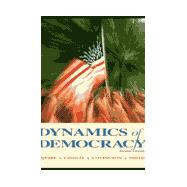
Note: Supplemental materials are not guaranteed with Rental or Used book purchases.
Purchase Benefits
Looking to rent a book? Rent Dynamics of Democracy [ISBN: 9780697327529] for the semester, quarter, and short term or search our site for other textbooks by Squire, Peverill; Lindsay James M.; Covington, Cary R.; Smith, Eric R. A. N.. Renting a textbook can save you up to 90% from the cost of buying.
| Studying the Dynamics of Democracy: Conflict, Rules, and Change | |
| Politics and Conflict | |
| Government as Rule Maker | |
| Putting It All Together: Context, Participants, Institutions, and Processes | |
| Summary | |
| Readings for Further Study | |
| Key Terms | |
| The Constitution | |
| The Constitution as a Reflection of Political Conflict | |
| The Constitution as a Reflection of the Founder's Philosophy | |
| The Core Provisions of the Constitution | |
| Three Consequences of the Constitution | |
| Federalism: The Vertical Dimension to the Constitution | |
| Readings for Further Study | |
| The Constitution of the United States | |
| The Social Context of American Politics | |
| Who Are Americans? | |
| Social and Economic Characteristics | |
| Diversity and Social Harmony Political | |
| Power in the United States | |
| Civil Liberties Interpreting the Constitution | |
| The Bill of Rights and State Government | |
| The First Amendment: Freedom of Speech, Assembly, Press, and Religion | |
| The Second Amendment: The Right to Bear Arms? | |
| Government and the Rights of Criminal Suspects Privacy as a Constitutional Right | |
| Civil Rights Civil Liberties and Civil Rights | |
| Discrimination Against African Americans | |
| Discrimination Against Asian Americans, Hispanic Americans, American Indians, and Others | |
| Discrimination Against Women Extending Civil Rights | |
| Affirmative Action: Equal Opportunity or Equal Outcomes? | |
| Public Opinion | |
| The People's Limited Knowledge of Politics | |
| The Nature and Acquisition of Opinions and Values Ideologies | |
| Public Opinion on the Issues | |
| Voting and Participation Who Votes? | |
| Political Activists | |
| How Voters Make Choices | |
| The News Media Do the News Media Matter? | |
| The Changing Face of the News | |
| Media Freedom of the Press | |
| Reporting the News | |
| Evaluating the News Media | |
| The News Media and Democracy | |
| Political Parties | |
| What Is a Political Party? | |
| Characteristics of the U.S. Political Party | |
| The History of U.S. Parties and Elections Modern Party Organization | |
| Interest Groups Defining Interest Groups | |
| The Growth of Interest Groups | |
| The Diversity of Organized Interests | |
| Interest Group Formation and Maintenance | |
| Interest Group Strategies | |
| Interest Group Influence | |
| The Balance Sheet on Interest Groups | |
| Congress The Structure of Congress | |
| The Evolution of Congress Getting | |
| There and Staying | |
| There-Congressional Elections | |
| Serving in Congress Congress as an Organization | |
| The Business of Congress Congress and the Idea of Representation | |
| The Presidency | |
| The Development of the Presidency | |
| Selecting a President | |
| The Presidency as an Institution | |
| The Presidency in American Politics | |
| The Federal Bureaucracy | |
| What Is Bureaucracy? | |
| The Structure and Tasks of the Federal Bureaucracy | |
| Development of the Federal Bureaucracy | |
| The Politics of the Federal Bureaucracy | |
| Reinventing the Federal Bureaucracy | |
| The Courts | |
| The Federal Courts | |
| The Federal Courts as Policy Makers | |
| The Supreme Court as a Political Institution | |
| Decision Making at the Supreme Court | |
| The Lower Federal Courts State Courts | |
| The Federal System and State Government | |
| Relations Between Federal, State, and Local Government | |
| State Government and Politics State Budgets Local Government Who Delivers? | |
| Public Opinion and Level of Government | |
| The Federal Budget Budgets, Deficit Spending, and the National Debt | |
| Where Does Government Revenue Come From? | |
| Where Does Government Spending Go? | |
| Why Do Budget Deficits Persist? | |
| The Budgetary Process Is the Budget Process Irrational? | |
| Domestic Policy | |
| Managing the Economy Regulating Business | |
| Promoting Social Welfare | |
| Foreign Policy | |
| A Brief History of U.S. Foreign Policy | |
| Foreign Policy | |
| Versus Domestic Policy | |
| Who Makes U.S. Foreign Policy? Challe | |
| Table of Contents provided by Publisher. All Rights Reserved. |
The New copy of this book will include any supplemental materials advertised. Please check the title of the book to determine if it should include any access cards, study guides, lab manuals, CDs, etc.
The Used, Rental and eBook copies of this book are not guaranteed to include any supplemental materials. Typically, only the book itself is included. This is true even if the title states it includes any access cards, study guides, lab manuals, CDs, etc.